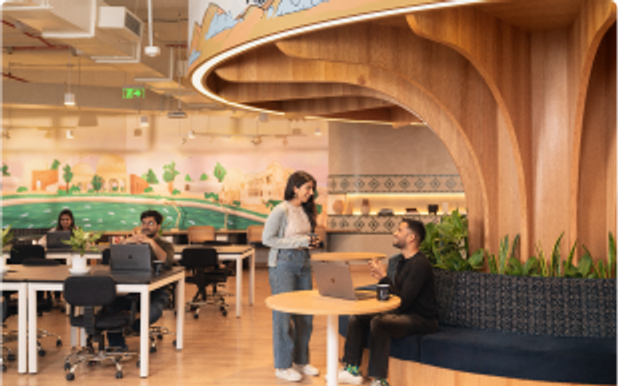NEWS & INSIGHTS
The open office concept: what it is and how it benefits modern workspaces

Learn about what is the open office concept, advantages of open space office and strategies to overcome challenges like noise and lack of privacy. Book now at WeWork!
The open office concept: what it is and how it benefits modern workspaces
In the evolving landscape of workplace design, the open office concept has gained significant popularity. This modern approach aims to foster collaboration, enhance flexibility, and improve productivity by breaking down the traditional barriers of cubicles and private offices. But what exactly is an open office concept, and how does it work? Let's delve into the details.
Understanding the open office concept
The open office concept is a layout where walls or high partitions do not enclose workspaces. Instead, it features a large, open area with desks and workstations arranged to promote interaction and communication among employees. This design often includes shared spaces such as communal tables, lounges, and breakout areas, creating a dynamic and fluid environment.
Different types of open office plans
1. Bullpen layout:
Desks are arranged in rows or clusters without any partitions. This layout is highly collaborative, ideal for team-based work, and encourages constant interaction.
2. Hot desking:
Here, employees do not have assigned desks. Instead, they choose any available workspace each day. This flexible approach can save space and adapt to changing team sizes.
3. Activity-based working:
Different zones are created for various tasks, such as quiet areas for focused work, collaborative spaces for team meetings, and relaxation zones for breaks. Employees move between these zones based on their activities.
4. Hybrid layout:
This layout combines elements of open office and private spaces. It offers a balance between collaborative areas and enclosed rooms for meetings or focused tasks, catering to diverse work preferences.
Also read: workplace culture
Benefits of adopting an open office plan
1. Enhanced collaboration:
The absence of physical barriers facilitates spontaneous discussions and teamwork, leading to increased creativity and problem-solving.
2. Flexibility:
Open offices can be easily reconfigured to accommodate changing team sizes and project needs, making them ideal for dynamic work environments.
3. Cost-effective:
By eliminating the need for multiple walls and partitions, open office plans can be more economical to set up and maintain.
4. Improved communication:
With fewer barriers, information flows more freely, fostering a culture of transparency and openness.
5. Better space utilisation:
Open plans can make more efficient use of available space, allowing for a greater number of workstations in a given area.
Also read: hybrid work model
Challenges of open office plans
1. Noise and distractions:
The lack of walls can lead to a noisy environment, making it difficult for employees to concentrate on tasks requiring deep focus.
2. Lack of privacy:
Without enclosed spaces, employees may find it challenging to have private conversations or work on sensitive tasks.
3. Potential for clutter:
An open layout can sometimes result in a cluttered appearance if not well-managed, affecting the overall aesthetics of the workspace.
4. Employee discomfort:
Not all employees thrive in an open environment; some may find it stressful or overwhelming, leading to decreased productivity and job satisfaction.
Frequently Asked Questions
What is an open office?
An open office is a workspace layout that features minimal physical barriers between workstations, promoting a collaborative and flexible work environment.
What are the types of open office plans?
Types include the bullpen layout, hot desking, activity-based working (ABW), and hybrid layouts.
What are the benefits of an open plan office?
Benefits include enhanced collaboration, flexibility, cost-effectiveness, improved communication, and better space utilisation.
What are the challenges of an open office plan?
Challenges include noise and distractions, lack of privacy, potential for clutter, and employee discomfort.
How can companies mitigate the challenges of an open office?
Solutions include implementing noise-cancelling measures, creating designated quiet zones, providing private meeting rooms, and involving employees in the design process to address their needs and preferences.
The open office concept, with its emphasis on collaboration and flexibility, offers numerous advantages for modern workplaces. However, it is essential to carefully consider and address the potential challenges to create a productive and comfortable environment for all employees.
Related Blogs:

NEWS & INSIGHTS
The world of finance saw a drastic shift in its functional trajectory the moment it was hit by the wave of AI. Like all the other fields of commerce,


